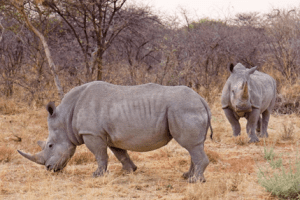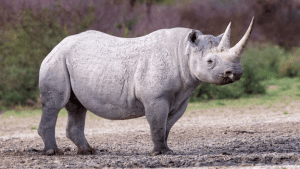TAG: GS 3: ECOLOGY AND ENVIRONMENT
THE CONTEXT: In a groundbreaking effort to combat rhinoceros poaching, South African scientists have developed a method to make rhino horns radioactive.
EXPLANATION:
- This innovative approach aims to deter poachers by rendering the horns useless for human consumption and making them detectable at border posts.
- South Africa is home to the majority of the world’s rhinoceroses, making it a prime target for poaching.
- Poachers are driven by the high demand for rhino horns in Asia, where they are believed to have therapeutic properties in traditional medicine.
- Despite government efforts, poaching remains a significant problem, with 499 rhinos killed in 2023, an 11% increase from the previous year.
The Rhisotope Project
- The “Rhisotope” project, spearheaded by director of the University of the Witwatersrand’s radiation and health physics unit.
- It involves injecting rhino horns with radioactive material.
- The project aims to protect the animals and curb the illegal trade in rhino horns.
- The procedure begins with tranquilizing the rhinoceros to ensure it feels no pain.
- Then a small hole into the horn is being drilled and inserts two tiny radioactive chips.
- This is followed by spraying 11,000 microdots over the horn to enhance detection capabilities.
- The dose of radioactive material used is minimal, ensuring it does not affect the health of the rhinos or the environment.
- Radioactive material would make the horn essentially poisonous for human consumption, thereby deterring its use in traditional medicine.
- The radioactive horns are designed to trigger detectors at international border posts, which were initially installed to prevent nuclear terrorism.
- This enhanced detectability aims to disrupt the illegal trade routes and make it significantly harder for poachers to smuggle the horns.
Pilot Project and Expected Outcomes
- The pilot phase of the Rhisotope project involves 20 live rhinos.
- The project team will follow strict scientific and ethical protocols for the animals’ aftercare.
- Blood samples will be taken to monitor the rhinos’ health and ensure the effectiveness of the protection measures.
Long-term Viability
- The radioactive material injected into the horns will remain effective for five years.
- This approach is more cost-effective than the current practice of dehorning, which needs to be done every 18 months.
- This could be a more successful deterrent against poaching than previous methods.
African rhino:
- The African rhino is divided into two species, the black rhino and the white rhino.
- White rhinos mainly live in South Africa, but they have also been reintroduced to Botswana, Namibia, Swaziland, and Zimbabwe.
- Southern white rhinos have been introduced to Kenya, Zambia, and Cote d’Ivoire.
- The majority of the black rhino population—98%—is concentrated in four countries: South Africa, Namibia, Zimbabwe, and Kenya. South Africa houses 40% of the total black rhino population.
- There are some black rhinos in the region spread between Cameroon and Kenya.
White rhinoceros:
- There are two subspecies of white rhinoceros: the southern white rhinoceros (Ceratotherium simum simum) and the northern white rhinoceros (Ceratotherium simum cottoni).
- The white rhino has an immense body and large head, a short neck and broad chest. Females weigh 1,600 kg (3,500 lb) and males 2,400 kg (5,300 lb).
- The head-and-body length is 3.5–4.6 m (11–15 ft) and the shoulder height is 1.8–2 m (5.9–6.6 ft).
- On its snout it has two horns. The front horn is larger than the other horn and averages 90 cm (35 in) in length and can reach 150 cm (59 in).
- The white rhinoceros also has a prominent muscular hump that supports its relatively large head.
 White rhinocerose
White rhinocerose
Black rhinoceros
- The black rhinoceros, black rhino or hook-lipped rhinoceros (Diceros bicornis) is a species of rhinoceros, native to eastern Africa and southern Africa, including Angola, Botswana, Kenya, Malawi, Mozambique, Namibia, South Africa, Eswatini, Tanzania, Zambia, and Zimbabwe.
- Although the species is referred to as black, its colours vary from brown to grey.
- It is the only extant species of the genus Diceros.
- The species overall is classified as critically endangered (even though the south-western black rhinoceros is classified as near threatened) and is threatened by multiple factors including poaching and habitat reduction.
- Three subspecies have been declared extinct, including the western black rhinoceros, which was declared extinct by the International Union for Conservation of Nature (IUCN) in 2011.
- The IUCN estimates that there are 3,142 mature individuals remaining in the wild.

Black Rhino
Spread the Word
